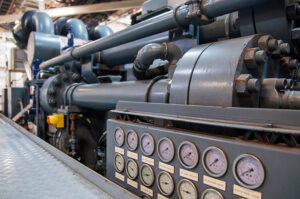Boilermakers who serviced boilers in ships or buildings may have been exposed to asbestos, putting them at a high risk of developing serious illnesses like mesothelioma. If you or a loved one has been diagnosed with mesothelioma, get help seeking justice and compensation now.
Boilermakers and Mesothelioma Explained
 Civilian and military boilermakers (also known as boiler tenders) who worked prior to the early 1980s are at a high risk of mesothelioma. At that time, boilers were made using many asbestos and asbestos-containing parts.
Civilian and military boilermakers (also known as boiler tenders) who worked prior to the early 1980s are at a high risk of mesothelioma. At that time, boilers were made using many asbestos and asbestos-containing parts.
The risks of asbestos were hidden from boilermakers by manufacturers of asbestos-containing products. These companies wanted to keep making money, and they put boilermakers and millions of others at risk in the process.
“I was a boiler tender when I went aboard my first ship and started doing my first job. I asked them what material it was made out of, and they told me asbestos. It didn’t kill anybody on the spot, that’s for sure. But, my understanding is that the asbestos companies knew.”
Thankfully, boilermakers with mesothelioma can access medical treatments and financial aid. Veterans with mesothelioma who served as boiler tenders may qualify for benefits from the U.S. Department of Veterans Affairs (VA) as well.
The Mesothelioma Veterans Center stands ready to help boilermakers with mesothelioma get all the benefits they deserve. Order our Free Veterans Packet right now to get started.
How Were Boilermakers Exposed to Asbestos?
Boilermakers must build, maintain, and repair boilers as part of their daily duties. Unfortunately, for most of the 20th century, boilers and nearby piping were insulated with asbestos-containing materials.
The manufacturers of boilers and related equipment began to use asbestos as insulation as early as the 1920s.
 Asbestos was considered superior to other forms of insulation because it was cheap and effective in keeping boilers fireproof and preventing heat from escaping.
Asbestos was considered superior to other forms of insulation because it was cheap and effective in keeping boilers fireproof and preventing heat from escaping.
Asbestos was a part of many military buildings, ships, and submarines built during World War II and for decades after.
The following companies made boilers that relied on asbestos:
- Babcock and Wilcox
- Combustion Engineering
- Foster Wheeler
- Kewanee Manufacturing Company
Often, boilermakers were tasked with hammering or filing rough areas of the boiler while working in small, enclosed spaces.
Disturbing the asbestos-containing boiler and its insulation released fibers into the small spaces where boilermakers worked. This made it easy for many boilermakers to inhale or ingest asbestos repeatedly over years of work.
Asbestos-Containing Boilermaking Products
Asbestos was used in many aspects of making boilers. For example, asbestos blankets were used to wrap the pipes that connected boilers to heat transfer systems. Boiler doors and nearby concrete and floor tiles could also contain asbestos materials.
Boilermakers who served aboard Navy ships are especially susceptible to asbestos. Many ship boiler rooms were outfitted with insulation made from asbestos.
Further, older boilers are still likely to contain asbestos-based materials, putting boilermakers at risk even today if proper precautions aren't taken.
If you were exposed to asbestos-containing parts while working as a boilermaker and now have mesothelioma, we can help you. Call (877) 450-8973 to learn more.
Asbestos-Related Diseases Among Boilermakers
Boilermakers could be at risk of many asbestos-related diseases, including:
- Mesothelioma
- Asbestosis
- Lung cancer
Any of these asbestos-related diseases can lead to fatal complications in boilermakers (and anyone else) without treatment.
“Past studies of boilermakers have shown increases in mortality from lung cancer and asbestosis and radiographic changes consistent with asbestos exposure.”
– American Journal of Industrial Medicine
It often takes 10-50 years between the initial exposure to asbestos and the development of asbestos-related diseases. For example, Walter Twidwell served as a Navy boiler tender and was diagnosed with mesothelioma more than 40 years after his service ended.
Benefits for Boilermakers With Mesothelioma
Boilermakers with mesothelioma deserve benefits, medical care, and financial aid following a diagnosis. Thankfully, many resources are available to help boilermakers. Learn about top benefits below.
VA Benefits
If you were a boilermaker in the U.S. military, you may be eligible for life-changing mesothelioma VA benefits. Applying for benefits can give you access to financial help and some of the best treatments for mesothelioma in the world.
As of 2025, married veterans with mesothelioma get nearly $4,000 monthly to cover living expenses, as well as medical care from top mesothelioma doctors working with the VA.
Find out how to start your mesothelioma VA benefits claim now.
- VA Disability Claims
- Survivor Benefits
- Finding Veteran Doctors
Private Mesothelioma Claims
Boilermakers with mesothelioma may be able to file a compensation claim against manufacturers of asbestos-containing products. Private mesothelioma claims usually pay out more than $1 million.
A private claim or mesothelioma lawsuit can provide funds for treatment and ease the burden on patients and their families. Filing a claim for compensation is not suing the U.S. government or military.
It may also be possible to file asbestos trust fund claims to get compensated if the companies in question went bankrupt. These funds contain over $30 billion.
You can reach out to our team to find out if you qualify to file a claim.
Help for Boilermakers Exposed to Asbestos
If you worked as a boilermaker and have been diagnosed with mesothelioma, asbestosis, or another asbestos-related illness, you have options.
Medical, military, and financial resources can help you live as long as possible and bring those who harmed you to justice.
Learn about all of the benefits you might qualify for in your Free Veterans Packet. And, if you were a military boilermaker, we humbly thank you for serving our country.
FAQs About Mesothelioma and Boilermakers
Are boilermakers exposed to asbestos?
Yes. Boilermakers could be exposed to asbestos since boilers and the surrounding insulation and piping relied on this material up until the early 1980s.
Boilermakers who were exposed to asbestos are at risk of mesothelioma and other dangerous diseases today.
Do boilermakers get cancer?
Yes, sometimes. Boilermakers exposed to asbestos on the job are at a higher risk of cancers like mesothelioma and lung cancer.
Boilermakers and other workers didn't know about the risks of asbestos exposure before the early 1980s when restrictions an asbestos were put in place. By that time, boilermakers had been relying on this deadly substance for over 50 years.
Boilermakers who worked with asbestos decades ago are still at risk of cancer today. This is because it can take 10-50 years before cancer tumors form following asbestos exposure.
Is there asbestos in boilers?
Possibly, yes. Dozens of older boilers were made with asbestos-containing materials. If these boilers are still being used in a home, building, or ship, it's possible that you could be exposed to asbestos if you try to work on them.
Always follow proper safety precautions and consult with professionals trained to remove asbestos before doing any work.

